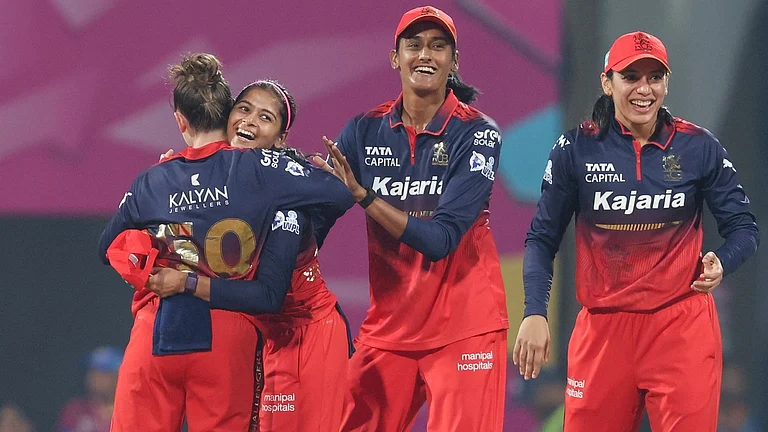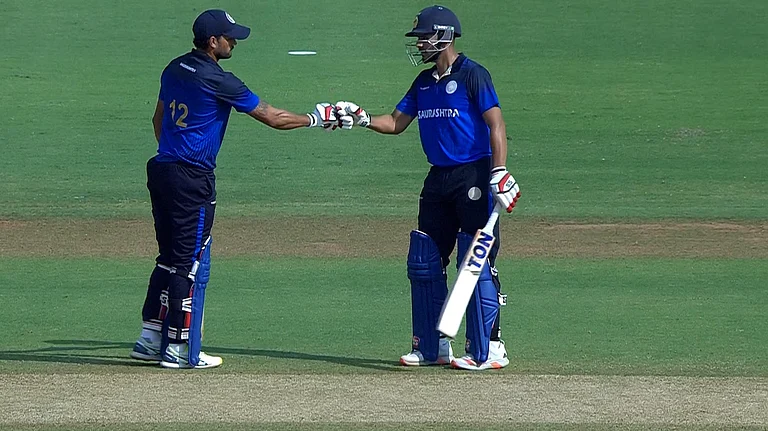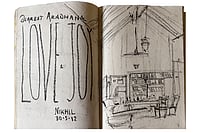Dedication
On December 4, the army killed 13 civilians near Oting in Nagaland’s Mon district. On November 2, 2000, at least 10 people were killed as they were waiting at a bus stop in Malom in Manipur. In July 1987, unarmed civilians were killed and many women raped, along with two who were forced to give birth in front of Assam Rifles troops, in what is known as Operation Bluebird. People call it the Oinam Massacre. There are countless other cases in Kashmir and other Northeastern states where AFSPA is imposed. This issue is dedicated to those who lost their lives, the ones who are waiting for justice and the ones who fought for it, like Irom Sharmila who fasted for 16 long years to get AFSPA repealed. It is dedicated to Thangjam Manorama Devi, who was allegedly raped and killed by Assam Rifles personnel in July 2004. It is dedicated to the memory of those who remember the killings. Their memory seeks justice.
They are the people of creation. Their maker…gives them the sky to carry because they are so strong. These people do not know who they are, but if you see a lot of trouble in your life, it is because you were chosen to carry part of the sky on your head.
—Edwidge Danticat, Breath, Eyes, Memory
The man on the wheel is in his sixties. And in the darkness, he talks about the darker truths about the place they call home. Nagaland, the land of blue mountains, and the black days they observe to commemorate the killing of innocents. Nagaland, the land of head-hunters and festivals. Nagaland, the disturbed place. Nagaland, the land of AFSPA, violence, tears and blood. He has many stories to tell. He has warnings to offer. Like the bows and poison-laced arrows that will avenge the killings, the othering, the other violence, rapes, killings and a memory that is soaked with trauma, a bloodied landscape inherited and remembered. He is the uncle of the young woman who had asked us to come to Mon to find the truth about the killings of civilians on December 4 and 5. She offered us her memory.
Kemya Yanlem had sent us her poem, And The Madman Laughs, in which she talked about her little town, Mon, and a madman who stood at the funeral of 14 people shot dead by the Indian Army. “14 wooden boxes that carry the weight of all the tears of us, and our ancestors…,” Kemya wrote. She wrote about her mother, who saw the smoke-filled town and heard the gunshots on December 5 and said, “Now it’s even coming to this land.” She told me about her grandfather, who was actively involved in the Indo-Naga political process in the 1950s, and later became a missionary. Why, she wondered.
ALSO READ: Poetry | New Terror in Nagaland
Yanlem said that in their part of the world, roads are sharp stones and pebbles. She is the “generation after”, which has a relationship with the personal, collective, and cultural trauma of those who came before, which they “remember” by means of images and stories and the context among which they have grown up. In her The Generation of Postmemory: Writing and Visual Culture After the Holocaust, Columbia University Professor Marianne Hirsch argues it is possible to remember other people’s memories. In Yanlem’s case, it is marginalia. A handed-down string of loss. Her memory is different from history, which is State-endorsed, even State-sponsored. Hers is concerned with justice. That elusive impossible thing here. She had sent pictures from the funeral in Mon. She had taken her camera there. For memory’s sake.
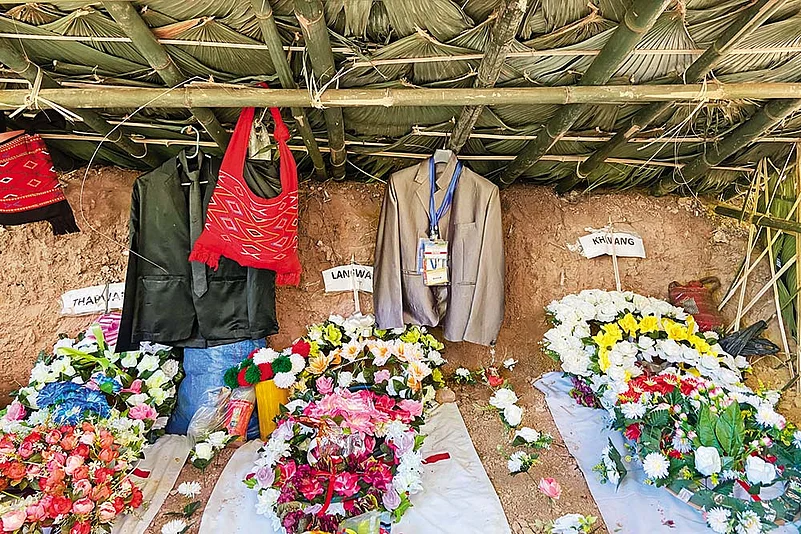
Graves of slain Konyaks at Oting. (Photographs by Chinki Sinha)
In yet another place under AFSPA, called Kashmir, poet Agha Shahid Ali once wrote these lines in his poem called Farewell. “My memory is again in the way of your history/Army convoys all night like desert caravans/In the smoking oil of dimmed headlights/time dissolved- all/Winter- its crushed fennel/We can’t ask them? Are you done with the world?” In places where forensic evidence goes missing and AFSPA gives unprecedented powers to the army, poetry is evidence too. A more powerful one. Memory preserved and passed. Lest we forget, as Naga poet Temsula Ao writes in the prologue of her book These Hills Called Home. “But what do you do when it comes to someone else’s memory and when that memory is of pain and pain alone? Do you brush it aside and say, it does not concern me?”.
We are here to acknowledge the pain of the recent killings and those years of bloodshed and tears that they have lived or heard about. That’s the thing about memory in these states. It stands in the way of history. Yanlem and others like her are the keepers of that memory.
The Ancient Bridge
It is the sixth day of mourning in Mon. There is a black flag on our vehicle. From Dibrugarh in Assam, the drive to Mon is long and winding. Distance is also the time taken to reach a place. The man on the wheel switches from the fantastical to the real. All stories belong in a “nowhere” kind of place. Here, in this part of the world, everything mixes. Like the clouds mix with the blue mountains, descend lower and hang on the rooftops and make the red Christmas stars a bit blurry. As if you were seeing all of this through fogged-up windows. The old man is from Mon. He is a retired school teacher.
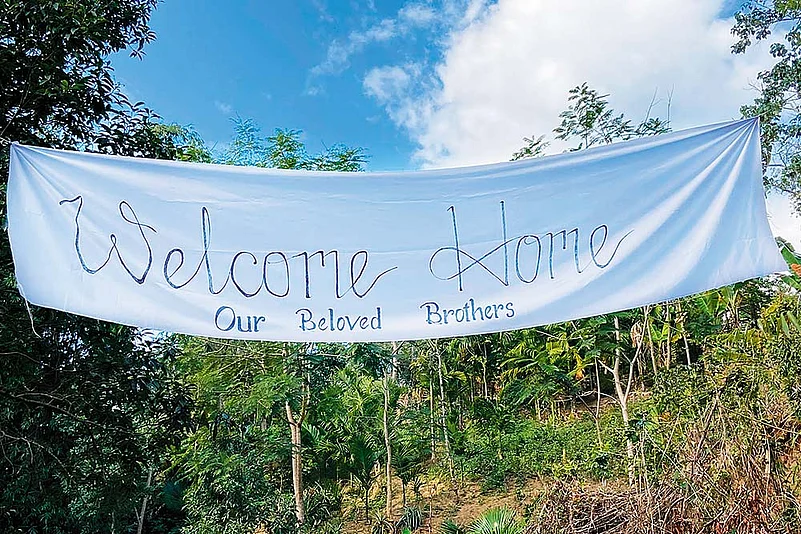
A banner at the entrance to the village. (Photographs by Chinki Sinha)
We drive through Dibrugarh and Moran, past tea estates and paddy fields. He asked for directions to Sonari, the last town in Assam before crossing over to Nagaland. The wooden bridge over Nailong river in Namtola is ancient. The man says it was built by the British. It collapsed in August 2019 and a truck fell into the river. The bridge decking crackles. The guard rail has a white banner. “Repeal AFSPA 1958 from Nagaland”, it says in red. Welcome to Nagaland.
Everything changes at once. There was a road but it doesn’t exist anymore. It could be a road again in the future, but hope is like soggy paper here. It means nothing, the man says. The security checkpoints are abandoned. “They have run away,” the man says. A ravaged landscape with wooden lodgings and no street lights lie ahead. “The Government of India is forcing us to become head-hunters again. We wanted peace. If there is no security, there will be no problem,” he says. That’s how he begins the narrative of the killings.
He is cautious at first. At some point when we are deep into the mountains, Nyamto Konyak begins to talk about the night when the ambush happened. “They were all poor people,” he says. “They shot them from the front. They weren’t warned. They were not fleeing. You’ll see.” The story will come in instalments. That we know. There is a lot of silence. We speak about ghosts. There are none here but there are a lot of dead here, he says. “They will be responsible for youth joining the insurgency now. All these years, we waited for peace. Now, the young have witnessed the bloodshed here,” he says. When we enter Mon, it is late. He invites us to have coffee at his place. A fire is burning. “Will you write this bit of history? His wife asks. “We want to make a booklet so the people remember these killings. Will you tell the people about AFSPA?”
We, the people from India’s mainland, who have never understood these hills they call home, promise that we will help them. That’s how we begin our reportage. That night, we were the only people at the guest house. The room has more than five windows. Every day, from my window, I see an impossible sky. Clouds and bluest skies. Diamond dust strewn across the sky. The moon, a saucer of all the silver.
The Konyaks, the last of Nagaland’s feared head-hunters, come from this place, Mon, which covers 10.77 per cent of the total area of Nagaland. It is bounded in the north by Assam, Arunachal Pradesh in the northeast, Myanmar in the southeast. They say insurgency is still active. People here had vowed no more bloodshed. Now, they have vowed non-cooperation with the army.
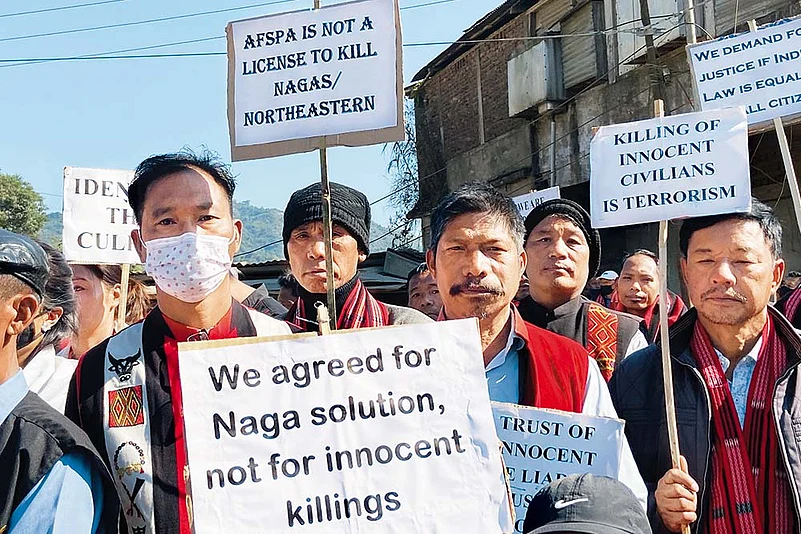
Protesters at Mon. (Photographs by Chinki Sinha)
The Witnesses
The Konyak Union’s (KU) office is on a little hill near the market, where women and men have lined up in front of a ration shop to get free food grains. This is a poor place, one of them says. “Poor people wait,” she says. Outside the office, black flags flutter in the wind. The office was vandalised by a mob on December 5 after the funeral was announced by the KU and the bodies still lay in the hospital. The mob had then burnt some part of the Assam Rifles headquarters in Mon. One person died that day. His name was Leiong Konyak from Chi village. His 30-year-old wife Eli Konyak, five months pregnant, is expecting their first child. Her husband went out on a Sunday morning to protest against the killings. His body came back in a coffin.
A large room at the back serves as a meeting room and a community kitchen for the KU members. Pangmei Konyak, the press secretary, talks about the inheritance of pain. “We have heard about so many deaths. Until now, they were stories and now, we have witnessed it with our own eyes,” he says. Building trust takes decades. This has dismantled every attempt now, he adds. Honang Konyak, the vice president, says he had heard from his father about another ambush in his village many years ago. “I see it now. We have no desire for more bloodshed,” he says. Pangmei leans forward. “At this juncture, we can’t tell what will transpire,” he says.
W. Manwang Anghaa, the secretary of Eastern Nagaland Peoples Association, refers to an old film about the Khmer Rouge in Cambodia, The Killing Fields. In the 1984 film, Dith Pran, the Cambodian journalist, writes in his journal, “The wind whispers of fear and hate. The war has killed love.” Is that what Manwang means when he asks me about the film? “Mistaken identity? Why were they trying to take away the bodies?” he asks. Honang, who returned to Mon after spending a few years in Delhi and working for Pratham, says he doesn’t know why they have been accorded the status of “disturbed” because this is a calm place.
Why did they kill? For gallantry awards? Or to create fear? Or because killing and raping are norms here. The perpetrators have been granted immunity. Or is it that the psychology of genocide, as explained by Yale Professor Stanley Milgram in 1963 based psychological experiments where he studied participants’ behaviour when asked to obey authority who instructed them to give electric shocks to a “learner” in what they were told was an unrelated experiment. The levels of these shocks were then raised to levels that were fatal and real.
Night of the Broken Glass
A yellow crime scene tape marks the perimeter of the incident spot here. At first, the pickup truck appears on the pebbled road from Oting to Tiru, about six km apart. More than a dozen bullet holes have made weblike patterns on the vehicle’s windscreen. Wangchaw Konyak walks to the site and crosses his heart. He stands silently looking at the windscreen with its numerous conferences around hollow holes. It is like the web of lies you weave, he says. The windscreen is a canvas of faint coruscations of sunlight like fireflies in a spider’s web. He points out to a thicket not very far from the pickup. “This is where they laid the ambush. This is where they shot from. Direct marise (they shot directly without warning),” he says. The Nagas speak a pidgin of Assamese and Hindi, with a few English words thrown in.
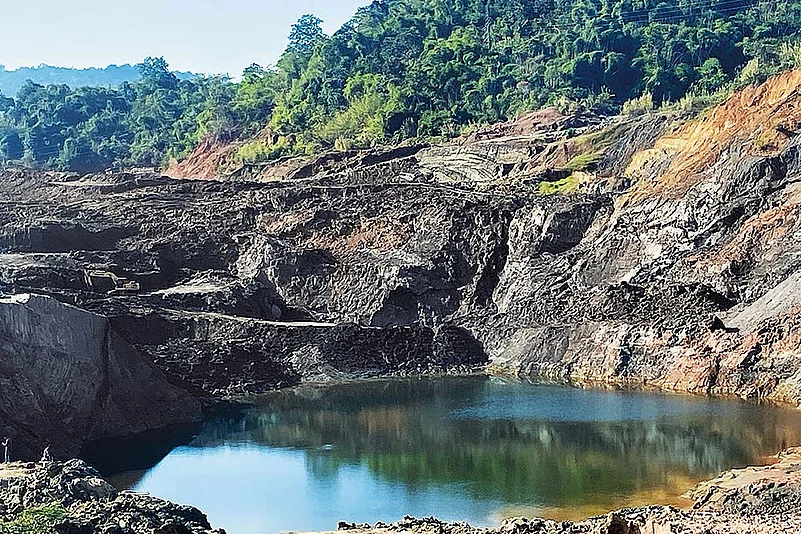
The good earth The coal mines at Tiru
On December 6, Union home minister Amit Shah addressed the Lok Sabha over the Nagaland firing incident and the ensuing violence and termed the first incident of December 4, when six miners were killed, a case of “mistaken identity”. He further said that “upon receiving the news, local villagers surrounded the army team, burnt two vehicles and assaulted them, resulting in the death of one Security Force (SF) personnel and injuries to several others. To disperse the crowd, SFs opened fire, which resulted in the killing of 7 more civilians and injuring some others.” Subsequently, the Indian Army’s 3 Corps released a press statement, deeply regretting the incident.
ALSO READ: Qutub Minar
To Wangchaw, nothing makes sense. We have driven on that road, the shorter one the villagers usually take, to reach this place marked as crime scene. “How do you even flee here,” he asks. “You can’t run on these roads even.” A little further stands a row of charred army vehicles. This could be a memorial to “othering” and this is what the villagers plan on doing here. They want to build a memorial dedicated to what they call the “Oting Massacre”, so they remember the night of the broken glass. They say the miners were singing Christmas songs that evening as they drove back to their village. That was their ritual. Go to the mines on Monday morning, return Saturday evening, attend church on Sunday. The village, perched on a mountain top, is home to around 200 families. Most men work in the open cast mines in Tiru, and commute to the workplace in pickup trucks. At the site, they live in ramshackle wooden huts during the mining season that runs from October to May. The mines came up around 15 years ago and most villagers work here as daily wage labourers, earning up to Rs. 500 a day. According to the numbers shared by the government in Parliament in 2019, Nagaland has the highest unemployment rate among the states at 21.4 per cent.
Keapwang Konyak, 31, the president of the student union in Oting village, had gone to his village on December 3 to attend the funeral of his neighbour who had died of natural causes. On December 4, he went down to Tiru to spend time with his friends. They heard the gunshots at around 4:30 pm as they were preparing to return to Oting for the Sunday mass the next day. At the time, Keapwang thought it was a gunfight between insurgents and the army. And at about 6:30, he left Tiru. They were diverted by the army and were asked to take another route. “Nobody in the village has anything to do with insurgency,” he says. “But AFSPA is creating terrorists.”
He managed to reach the scene of crime along with others and saw the pickup truck’s bullet-riddled windscreen. They asked the army about the people in the pickup truck and were told another team had taken them. That’s when they saw the other pickup truck moving on the road. They stopped their bikes in front of it and asked the army personnel again. That’s when Keapwang got off the bike and pushed his hands inside the tarpaulin sheet and felt the limp hands and feet of the bodies. “The army personnel had spread this tarpaulin and were sitting on top of the bodies. We also found camouflages. They would have taken them and declared them as terrorists,” he says.
That’s when the army personnel started firing. The villagers burnt their vehicles. Nobody knows how many were there. Probably 19, Keapwang says. Seven more died and dozens were injured in the second round. The army personnel fled.
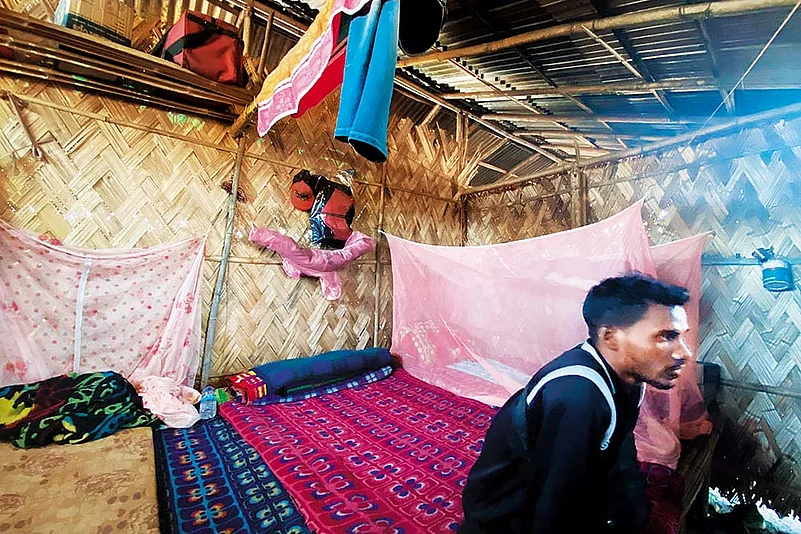
An FIR was registered over the incident at the Tizit Police Station and was later transferred to the State Crime Police Station. A Special Investigation Team (SIT) has been constituted and directed to complete the investigation within a month. Mon Deputy Commissioner Thavaseelan K says it was an unfortunate incident. “I have given my call records and other evidence narrating the sequence of events that night as part of the SIT investigation,” he says. Families of the deceased have received ex gratia of Rs 16 lakh each—Rs 11 lakh from the Centre and the rest from the state government. Besides, those with serious injuries have received Rs 1 lakh each and Rs 50,000 each by those with minor injuries. Besides the 14 dead, there are 18 with major injuries, while 17 sustained minor injuries. Of the two injured in the pickup truck, one has had an advanced eye surgery in Guwahati. The other one is in a government hospital in Dibrugarh. The families of those who died have been promised Rs 16 lakhs, 11 from the central government and 5 from the state. Nobody visited Mon. Not the home minister. Not the Prime Minister.
Welcome Home
When you enter Oting on top of a mountain, a white banner awaits. It says, “Welcome home our beloved brothers”. It sets the narrative of grief in this small village. At the graveyard, there are no plinths yet. It is too early. It has only been nine days since the deaths. A structure stands. It is bigger than the others. Like a hut with thatched roofs held together with bamboo poles. Inside, there are twelve fresh graves. Alongside and on top of the graves, there are various things. Perhaps the dead loved those or they are just offerings by the family and the villagers. One even had a wedding suit. The man had been married for only nine days. His widow Monlong hung the suit at the grave of Hokup. Hokup was one of the miners. He was killed later that evening when he went to look for his friends after they heard the gunshots. He had been at the Tiru mines then.
Outside, a huge banner with messages was hung. As a tribute. As an expression of anger, of loss and of grief. It called for the repeal of the Armed Forces (Special Powers) Act (AFSPA), 1958 from the state. It said Naga people didn’t want bloodshed. It said the dead cannot cry for justice, so the living should ask for justice for them. The plastic wreaths in pink and white and lavender coloured flowers cover the 12 graves. Perhaps plastic endures. This would be a test for their endurance. There are black flags everywhere. Until justice is done, black flags will flutter in the wind.
There are no Christmas buntings in Oting. No stars are hung. No fairy lights light up the cold nights here. One had a child two months ago. Another was planning on getting married. A mother lost her twins. Another lost her only support. Twelve were laid to rest in the village cemetery after the funeral in Mon. Their graves are in a row. On the graves, there are simple tributes. A bar of chocolate, Maggi noodles packets, a muffler, a pair of socks, wafers and cloth bags with the motifs of the Konyak tribe. A lot of flowers, too. The ones that will endure the winter. In this harsh place, the plastic flowers will survive. And so will their memory of the killings.
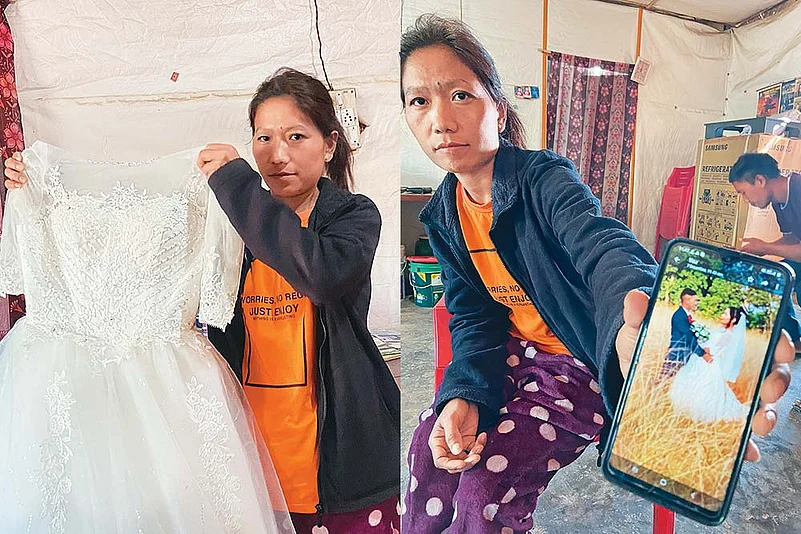
White Wedding Gown
Her fingers, long and steady, go up and down the screen. Monlong, 35, holds the phone steady in one hand and sometimes, her fingers pause, join and then two of them begin a journey of separation and in that ritual, a photo is enlarged. It is from her wedding. She is in a white dress studded with pearls and crystals. He is in a black suit. They are in a field, their backs to each other. In another, they are facing each other. A typical wedding photoshoot. All that remains of those vows of being together as man and wife is a bunch of wedding photos, a lot of uncertainty and a void. They were married on November 25 in the church adjacent to her living quarters. Her wedding gown was bought in Dimapur. So was Hokup’s suit. Now, the wedding suit is hung at the grave. Her ensemble is packed away in a trunk. She brings it out, unfolds it, smoothens the crease and says she liked the way it fell. Like an umbrella around her waist.
They met at the church. She came to work at Oting’s Baptist Church in 2014. He was in the choir and she was part of the women’s wing. They liked each other. They sought permission to have a white wedding. And they solemnised their wedding in Oting. A feast followed. There must have been singing and dancing but these are cruel questions to ask. A cat came by. The quarters are spartan. Two doors on one wall lead to two rooms. She sleeps in one. In the other, she has stored her things. In the big room, where they have their meetings, there is a table. That’s where a few wedding cards are scattered. Hers isn’t there. But she goes inside one of the rooms and brings a card. It has two figures outlined in silver. “My wedding card,” she says. She goes inside again. There is an uncomfortable silence in the room. A man sits in a corner. She returns with a framed certificate of her marriage. The glass is cracked. Ominous signs. She smiles and says nothing. She doesn’t speak much except to recount how she came to know her husband had died. He had gone back to Tiru mines on November 30 and returned only on December 30 for a funeral in the village, and left the same evening. She had cooked for him that day. Sticky rice, she says. That evening, she had heard the gunshots. She called Hokup’s phone but he didn’t pick up. Around 10 pm, she sent a message.
“Are you alive or not?” Around midnight, she called again. His friend picked up and said Hokup had been injured. He lied, she says. “He said his hand was injured,” she says. She insisted on talking to him but Hokup’s voice was barely audible. He had been shot in the chest. He was taken to Tizit to a hospital but was declared dead at arrival. She came to know Hokup had died at 3 am on December 5.
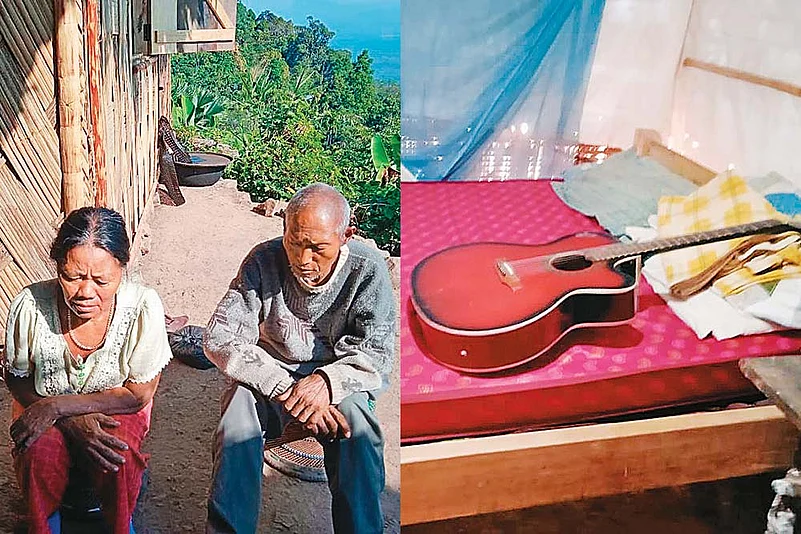
And a little later, she talks about how they met. They have not had the time to process this grief. There is a long pause again. We, who are intruders, want a story. She, the one left behind, is a witness, a participant, a carrier, a holder. We don’t know how to talk to her. At one point, her voice loses its steadiness. It dips. Her eyes hold a tear or two. She goes quiet. Future is a question that holds many endings and many beginnings. In a place like this, endings have outnumbered beginnings. They had been planning on buying a plot of land in Tizit and building a house. They wanted to go for a honeymoon somewhere. She is wearing an orange t-shirt. On it, there is a line—Nothing is Everlasting.
The Twins
Awan Konyak doesn’t go to the room that belonged to her twin sons—Langwang and Thanpwang. She saw them last on November 29 when they left for Tiru. Both worked in the coal mines. They were born in 1998. They dropped out of the school in Class-IX because they couldn’t afford to study further. They had wanted to become drivers at the mine but they weren’t qualified, so like others, they worked as daily wage labourers. Before they were killed, they were planning to go Christmas shopping in Tizit. She doesn’t say much. We don’t ask much. But she gets up and starts walking to their room. There is a guitar on the bed. The twins had bought it to sing in the local church. “They made a kitchen,” she says. Their elder son is mentally challenged. The twins would earn Rs 400-500 per day during the mining season like others in the village. The room has been locked ever since they buried their twins. She packed their things and left them at the grave except for the guitar. That stays in the room.
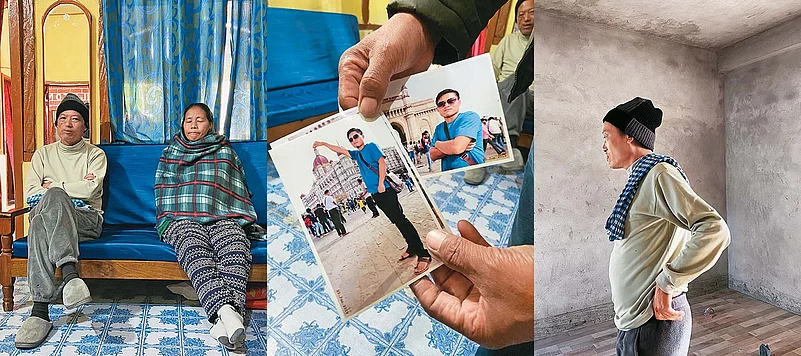
The Rooftop Room
From a window of the room, you can see the sun rising in the east and from the other, the setting sun beyond the hills. You can also see the Tiru mines in the distance. The rest is all green and blue. Hills, jungles and peerless blue skies. Except that, in this room, there is no future. There is no past either. Just a void. It is empty. The father Chemwang Konyak points out to a wall and says this is where the son Shomwang, 32, wanted to build an almirah. The room’s unfinished. A life was cut short. His son had been driving the pickup truck that evening. He died on the spot. This room is now a site of unfinished everything. The mason is on leave and when he returns, he will build it just as his son had wanted it, the father says. It will be his memorial. It will contain all his future that is now eternal. For a long time, the father stands on the rooftop looking at the mines. He had slowly walked up the staircase to show this room his son had been constructing to live in after his wedding. He was engaged. His fiancée had shown up for the funeral. His other room, the one that contains his past, has a window. His things have been given away. Only two suits remain. His Sunday church outfits. Packed and hung in the open shelf.
Everything else is gone. It is not an erasure. Nothing like that can be attempted here. The mother Pokhao shows a couple of photos. Her son is in a blue jumper in front of the Gateway of India. In another, he is posing in front of the Taj Mahal Hotel. The father is a cancer patient. They had gone to Mumbai for his treatment. He had been struggling to earn money for his father’s treatment. That evening, he was driving the pickup truck and had gone to pick up his friends. The father owns a few mines in Tiru. He was the eldest son and dropped out of college to help the family. In 2022, he would have got married. “He liked the sea,” the father says. The sea. In another place. Loved by Shomwang who was tied to the mountains.
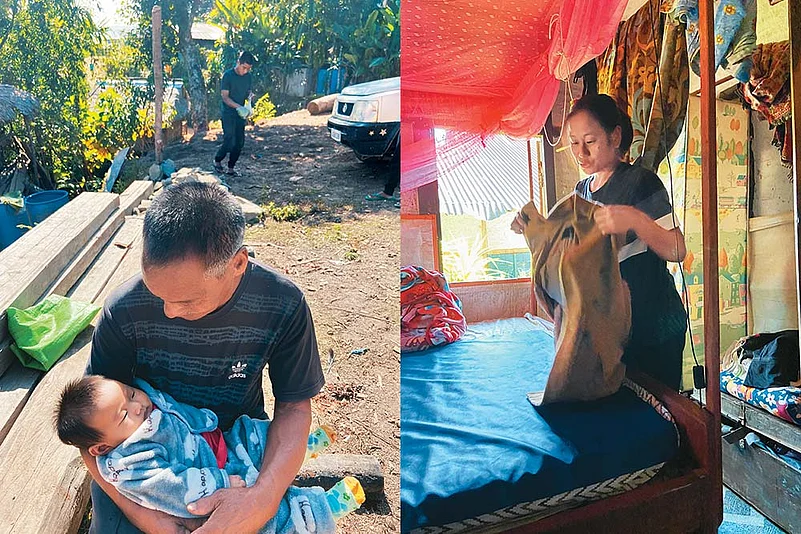
The Brown Coat
The pink mosquito net has a rose attached to a string. A pink rose made of cloth. Two windows on two walls and a square plastic sheet for the baby on the bed. A world in its own right. This was their room. There’s a wooden box in her room next to the door. Ngamlem, 30, takes out a brown wool peacoat and lays it out the bed. It is a gift. For Christmas. Langtun, 37, is no more. He probably bought it from one of those shops in Mon’s Christmas market where they sell second-hand coats and jumpers. She moves her hand across the lapel to iron out the creases. They were married last September. There was no white wedding. He had fallen in love in Tiru, where she comes from. There will be no Christmas celebrations this year. In the other room in this old house, there is a framed poster. It says Rejoice in the Lord. She looks at it and then walks out of the door. The child is sleeping in her father-in-law’s lap.
The woman, like the other widow, keeps scrolling through her phone. That’s one way to remember perhaps. They have decided her fate already. The younger brother, Mosa, will marry her after the church sets a date. That’s how it happens here, the elder brother Jenwang says. Yingmei is only two months old. She needs a fatzher, he says. “We are labourers. It was love at first sight. That was our leap of faith,” she says. “We can’t afford to dream anymore.” She is resigned to her fate. She sits under that pink net canopy and scrolls through her past. His pictures, the baby’s pictures and their pictures. There’s always that. And the brown coat.
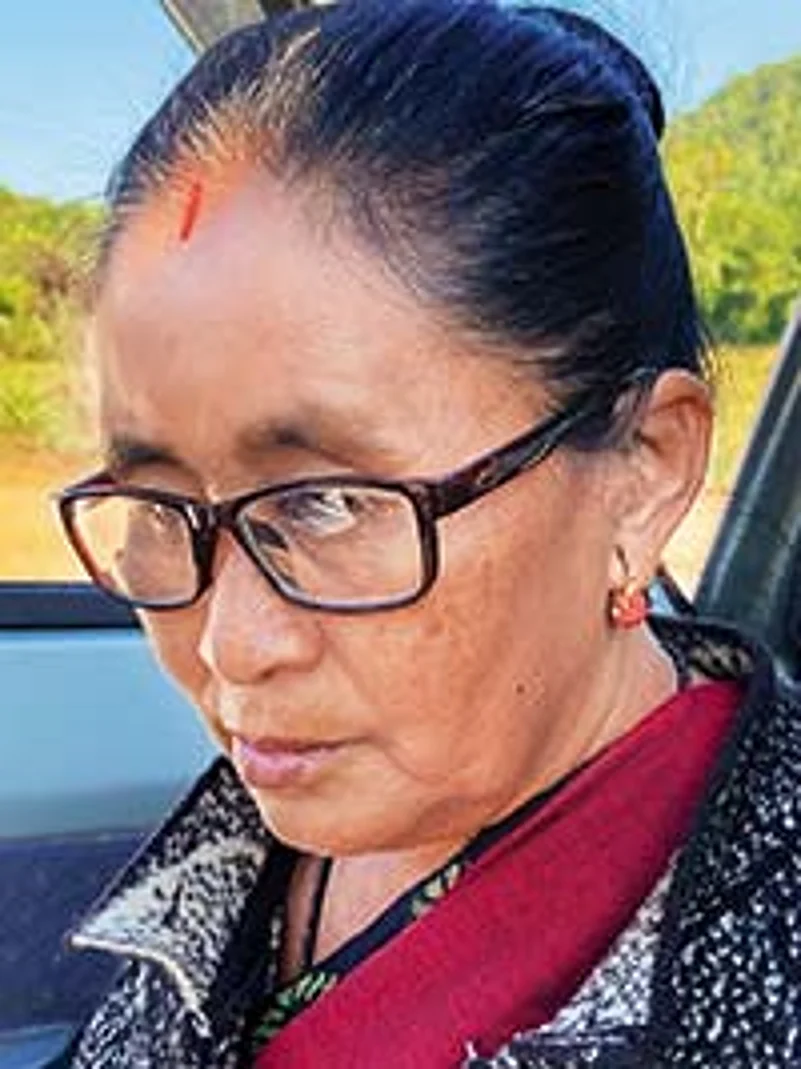
Money For Nothing
Hers was the saddest face among the wedding guests at Tiru that afternoon. Yongmei Konyak, 56, clutched a packet with a gift for the newlyweds. She came to the wedding because the families had been neighbours. Her son Bipul was shot dead that night. Her son was her only support. He had dropped out of Class-VIII because they were poor and he had to start working to support his parents. “There is no way out of poverty,” she says. They have received the ex-gratia payment. Rs 16 lakh. But that’s no substitute for a son. How do you pay for love?
The Last Post
That evening, we decided to turn back. Let the people mourn their dead. The graveyard is a storyboard. The question lingers. Why did they do it? But there’s the SIT and the army investigations that’s ongoing. They have asked for eyewitness accounts, have set up helpline numbers, etc. Due processes, they’d argue. We closed the notebook. There is enough grief, enough “human interest” for the pages.
They say beauty is a curse. The blue mountains turn a deep shade of midnight towards the evening. A few red Christmas stars light up the streets. There are no street lights. There aren’t even streets or roads for that matter. This is another place. A place we haven’t tried to know about. A place that comes to us as photos of people brandishing their spears and we, the voyeurs, relish the tales of the head-hunters. And we discuss endlessly if the Nagas eat dog meat and if they have human skulls in their homes.
That’s why Yingpe, a local princess, said that behind the blue mountains, there are tragic stories of people in a “disturbed” place. “You will not know what it means to be here,” she said. Vigils and protests. Black flags and defiance. And endless blue mountains and countless stories about their identity and their struggle is what defines this place. Later that night, I wrote down Mon in my notebook. And then, I inserted “ur” in between “o” and “n”. Just like that. A girl had said that in Mon, they now mourn. For now.
(This appeared in the print edition as "Mountains of Memories")
Chinki Sinha in Mon, Nagaland








